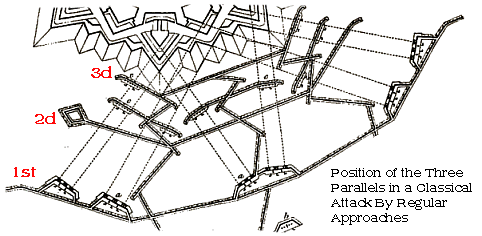 Parallels were siege works used to provide
defensive positions that allowed the besieging army to hold the ground gained
in its approaches directed toward the point of attack. As the approaches
advanced the parallels were also used as forward supply depots where siege
materials necessary to complete the trenches in front were collected. Their
name suggests their general orientation to the point of attack: parallels
were laid out either parallel to the point of attack or on a concentric line
that enveloped the point of attack. The First Parallel could be opened anywhere
from 1,500 to 600 yards from the point of attack and was usually constructed
by means of the simple sap. Each subsequent parallel was positioned within
canister range of the preceding parallel so that the full extent of ground
covered by the approaches would be well swept by defensive fire. The
Second and any subsequent parallel within enemy artillery range, but beyond
musket range, were usually constructed by means of the flying sap; parallels
within musket range of the salient of the point of attack were constructed
by means of the full sap. Unlike boyaux, parallels were provided with banquettes
that allowed infantry to fire over the parallels' parapets. Batteries and
magazines could be Parallels were siege works used to provide
defensive positions that allowed the besieging army to hold the ground gained
in its approaches directed toward the point of attack. As the approaches
advanced the parallels were also used as forward supply depots where siege
materials necessary to complete the trenches in front were collected. Their
name suggests their general orientation to the point of attack: parallels
were laid out either parallel to the point of attack or on a concentric line
that enveloped the point of attack. The First Parallel could be opened anywhere
from 1,500 to 600 yards from the point of attack and was usually constructed
by means of the simple sap. Each subsequent parallel was positioned within
canister range of the preceding parallel so that the full extent of ground
covered by the approaches would be well swept by defensive fire. The
Second and any subsequent parallel within enemy artillery range, but beyond
musket range, were usually constructed by means of the flying sap; parallels
within musket range of the salient of the point of attack were constructed
by means of the full sap. Unlike boyaux, parallels were provided with banquettes
that allowed infantry to fire over the parallels' parapets. Batteries and
magazines could be
 constructed within parallels by widening the trench,
or secondary boyaux could be extended from the parallels to battery positions
between parallels. Parallels could be anywhere from eight to 12 feet wide
to insure unencumbered circulation of troops and material through the approaches. constructed within parallels by widening the trench,
or secondary boyaux could be extended from the parallels to battery positions
between parallels. Parallels could be anywhere from eight to 12 feet wide
to insure unencumbered circulation of troops and material through the approaches.
When the approaches were threaten by enemy sorties the fronts
of the parallels could be covered by obstacles such as abatis, palisadings,
and entanglements, though the extra labor involved in constructing extensive
obstacles was usually too expensive in time and material for most attacking
armies. In the event of an enemy sortie against the head of the approaches
the saps forward of the last completed parallel were quickly abandoned and
troops were concentrated in the parallel to repel the sortie. On Morris Island,
South Carolina the attacking Federal force covered the front and flanks of
its parallels with very elaborate obstacles, which
 caused an
important delay in the advance of their approaches, due the fear that a
successful Confederate sortie would drive the besieging force into the Atlantic
Ocean. Their fear of sorties was almost completely eliminated when the head
of their sap ran into a line of mechanically detonated torpedoes about 200
yards from the ditch of Fort Wagner. The torpedoes strongly suggested that
the Confederates would limit themselves to a passive defense of the ground
in front of Fort Wagner. From that point the Federal approaches were able
to proceed more rapidly and without the need to construct defensive works
to protect the head of the sap. At Vicksburg the Confederates generally conducted
a rather passive defense which allowed Federal approaches to move quickly
through ground where they would otherwise have been forced to construct defensive
works. In one of the few cases in which the Confederates did launch a sortie,
they were able to capture about 50 yards of a Federal sap and fill it in
before withdrawing to their main defensive line. caused an
important delay in the advance of their approaches, due the fear that a
successful Confederate sortie would drive the besieging force into the Atlantic
Ocean. Their fear of sorties was almost completely eliminated when the head
of their sap ran into a line of mechanically detonated torpedoes about 200
yards from the ditch of Fort Wagner. The torpedoes strongly suggested that
the Confederates would limit themselves to a passive defense of the ground
in front of Fort Wagner. From that point the Federal approaches were able
to proceed more rapidly and without the need to construct defensive works
to protect the head of the sap. At Vicksburg the Confederates generally conducted
a rather passive defense which allowed Federal approaches to move quickly
through ground where they would otherwise have been forced to construct defensive
works. In one of the few cases in which the Confederates did launch a sortie,
they were able to capture about 50 yards of a Federal sap and fill it in
before withdrawing to their main defensive line.
[This page originally appeared as a Basic Information Page
on the old Civil War Field Fortifications Website] |